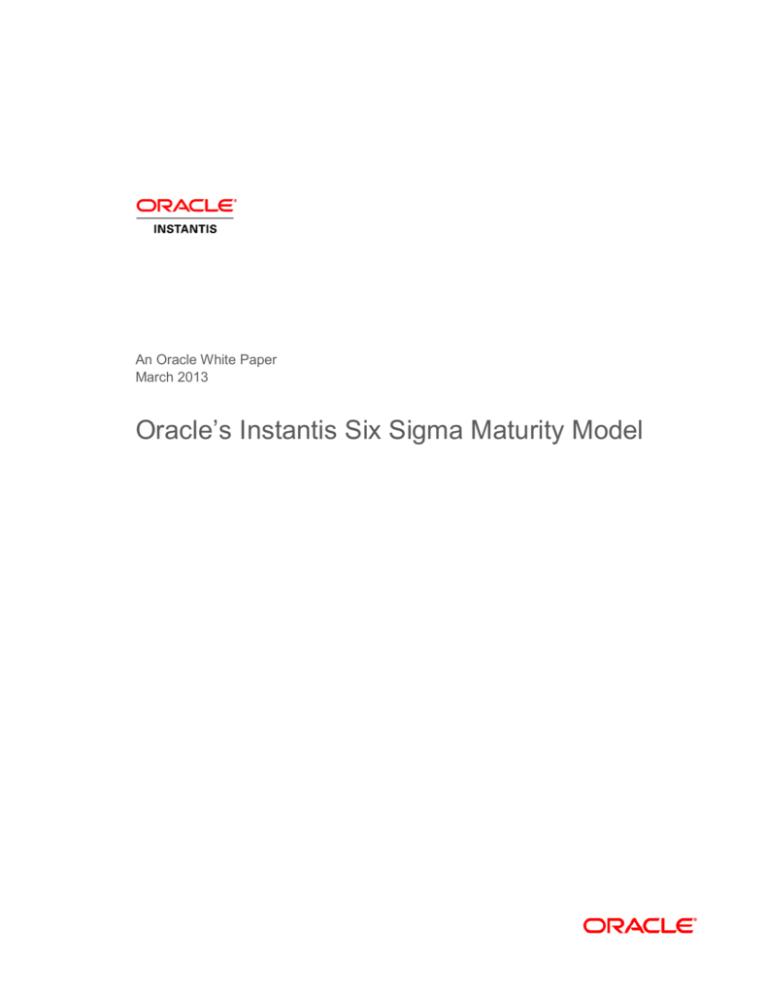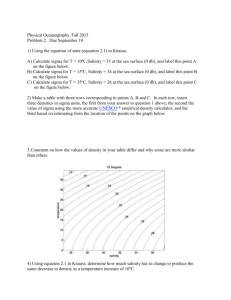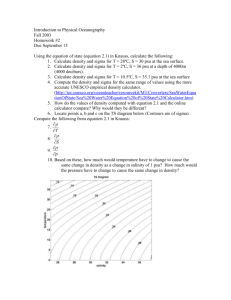
An Oracle White Paper
March 2013
Oracle’s Instantis Six Sigma Maturity Model
Oracle’s Instantis Six Sigma Maturity Model
Introduction
As organizations adopt and deploy Six Sigma, they evolve through several levels of maturity.
Oracle’s Instantis Six Sigma maturity model represents the first attempt to outline the five
commonly experienced levels of Six Sigma development. Describing the Six Sigma journey
from launch and early success to culture transformation, Oracle’s Instantis Six Sigma maturity
model helps Six Sigma practitioners, deployment leaders, and executives accomplish the
following goals:
•
Benchmark where their companies stand in relation to broader patterns experienced by other
organizations
•
Assess the areas of strength and performance gaps in their deployments
•
Pinpoint steps they might take to close gaps and graduate to the next phase of their Six
Sigma journey
•
Communicate progress to Six Sigma teams and within companies to garner additional
support for continuous improvement efforts
Since the model was first published, in October 2006, more than 1,000 copies of this white
paper have been downloaded.
1
Oracle’s Instantis Six Sigma Maturity Model
“We’ve started to use the Six Sigma maturity model as a standard for benchmarking continuous improvement programs within
Chevron and also across the energy industry. The model provides a much needed industry standard for gauging progress.”
Stephen Turnipseed
Lean Sigma Advisor, Chevron
Model Overview
Oracle’s Instantis Six Sigma maturity model outlines each of the five maturity levels along various axes
and describes how an organization evolves along these axes as it progresses through the levels. The
model also includes time frames representing the typical amount of time spent at each level, and simple
exit criteria define the transition from one level to the next. The model is designed as a general
guideline, not a strict prescriptive roadmap for Six Sigma implementation.
The five levels are
•
Launch. This is the starting point—when Six Sigma is launched, training is initiated, and projects are
begun.
•
Early success. The initial projects are yielding results, and early successes are being achieved.
•
Scale and replication. Early success has led other parts of the organization to buy in to Six Sigma,
meaning that a broader project launch is under way.
•
Institutionalization. Projects are yielding broad-based financial impacts throughout many parts of
the company.
•
Culture transformation. Six Sigma has become part of the organizational DNA, the financial
impact is now sustained, and Six Sigma culture is pervasive (even beyond the Six Sigma practitioners
and company boundaries).
Figure 1. The five levels of Six Sigma maturity are described along a variety of axes.
2
Oracle’s Instantis Six Sigma Maturity Model
Level 1: Launch
Typically, Six Sigma is launched within an organization as a result of a “burning platform” in the
business. Other typical drivers include the arrival of a CEO with a Six Sigma background, the results
of a competitive benchmarking exercise, or a bottom-up effort in a business unit. Thus, a launch can
be either top-down or bottom-up, but launches are generally quicker and more successful when they
are top-down.
The launch usually occurs with the help of an external consulting and training firm. Consultants
typically preside over initial executive and champion sessions designed to establish the potential
impacts of Six Sigma on business operations, revenues, costs, and company culture. There is buy-in to
start the initial training sessions to certify a core group of Black Belts and Master Black Belts who will
lead the initial projects. Organizations generally appoint a vice president or a director of Six Sigma,
who reports to an executive sponsor and whose charter is to ensure successful deployment of Six
Sigma. In bottom-up launches, there may not be as much senior executive involvement; support may
exist only at a divisional level.
TABLE 1. LAUNCH AXES
AXES
CHARACTERISTICS
Leadership
Initial visionaries are needed to provide impetus for adoption; top-down or bottom-up.
Training
Executives are trained by external trainers; champion training begins; initial Black Belts are
identified and trained.
People
There are a few driven believers; the rest of the organization is largely skeptical.
Project selection
Focus is provided by a burning platform; the organization needs to manage excessive
expectations and avoid overreaching.
Financial impact
No impact has occurred yet; no projects are completed.
Reporting
No formal reporting has taken place yet; no projects are completed—progress is reported in
qualitative terms.
Key Challenges
The key challenges at Level 1 are to ensure that the team executing the Six Sigma effort has the
requisite organizational support and that projects are properly selected to drive successes at the next
level.
Duration and Next Level
This level typically lasts three to nine months. An organization moves to the next level when initial
training has been completed and the first set of projects is under way (although not yet completed).
3
Oracle’s Instantis Six Sigma Maturity Model
Level 2: Early Success
At this level, initial projects are well under way. In fact, many have been completed. Improvements
have already resulted in significant financial and other impacts, and the support given to the initial team
has been validated by early results. At this critical “show me” stage, early successes must be made
visible so that the rest of the organization can see Six Sigma’s impact. This is where ambiguity and
uncertainty about Six Sigma’s business impacts are replaced by proven, relevant examples of business
problems addressed by successful Six Sigma application.
TABLE 2. THE AXES OF EARLY SUCCESS
AXES
CHARACTERISTICS
Leadership
Completed projects validate leadership’s vision.
Training
A few waves are completed; trainers are usually still external.
People
Initial results are helpful, but many in the organization remain skeptical—waiting to see how Six
Sigma will affect them.
Project selection
Low-hanging fruit (easy-to-identify, high-impact projects) is plentiful.
Financial impact
Initial results, usually in the area of cost reduction, are having some impact.
Software
Focus is on statistical tools for the Belts.
Key Challenges
The key challenges at Level 2 are to ensure that projects are completed in a reasonable time and that
those projects have a meaningful financial impact on the business.
Duration and Next Level
Typical companies remain at this level between 6 and 18 months. A company moves to the next level
of Six Sigma maturity when initial successes have begun to drive Six Sigma adoption in other parts of
the company.
4
Oracle’s Instantis Six Sigma Maturity Model
Level 3: Scale/Replication
At this level, the company has experienced solid success from the initial deployment and is now
witnessing that other parts of the organization are buying into Six Sigma. At this stage, the Six Sigma
effort scales companywide and gathers momentum. Many waves of training are in progress across
many parts of the company. Projects are being pursued at multiple organizational levels.
TABLE 3. THE AXES OF SCALE/REPLICATION
AXES
CHARACTERISTICS
Leadership
The decision has been made to drive Six Sigma throughout the company; leadership across the
company buys in.
Training
Many waves are occurring across the company; trainers are often external.
People
New believers in different parts of the company generate program momentum; change agents
throughout the organization see a platform with proof points.
Project selection
Established patterns of success are being replicated (similar projects for similar problems in similar
plants, branches, distribution centers, and so on).
Financial impact
Consistent measures of impact are in place.
Reporting
Enough projects are completed that the average impact per project, per Belt, and so on can be
predicted and cross-organization comparisons can be made; aggregate impact across the
organization is significant.
Software
Software moves beyond statistical tools to project tracking; consistent application of methodology
and financial impact reporting is ensured.
Strategy
Strategy maps are created to ensure that projects are aligned with corporate and organizational
priorities.
Key Challenges
The key challenges at Level 3 involve ensuring that the methodology is consistently applied in other
parts of the company and that the financial impact and results are replicated. It is important to have a
strong company deployment leader who can ensure consistency of methodology and results.
Duration and Next Level
The scale/replication level typically lasts between one and three years. A company progresses to the
next level of maturity when all of its internal organizations have moved from replicating initial
successes to a deep adoption of Six Sigma from within.
5
Oracle’s Instantis Six Sigma Maturity Model
Level 4: Institutionalization
At this level, companies have replicated their initial success throughout their organizations. There is
enough financial impact from projects in each organization that meaningful comparisons can be made
of average project impact, average cycle time, total impact, and so on. The Six Sigma deployment has
evolved to include formal processes tailored to each organization’s training needs, a unique project
selection process, and professional development paths for Belts. Project financial impact measures are
highly evolved, and Six Sigma processes have become institutionalized throughout the company.
TABLE 4. THE AXES OF INSTITUTIONALIZATION
AXES
CHARACTERISTICS
Leadership
Top leadership across business units, geographies, and divisions supports Six Sigma.
Training
It is very widespread; usually external, it involves some in-house Master Black Belts as
trainers.
People
Six Sigma represents a clear career path; those in initial Black Belt waves have been
repatriated, with enhanced career prospects and positions within the organization.
Project selection
A formal idea-generation/evaluation process is in place to ensure continued flow of
meaningful projects; there is no more low-hanging fruit.
Financial impact
Strict controls are in place to ensure validation of results; measures evolve to include
revenue impact.
Reporting
Aggregate corporatewide results are reported externally to the financial community.
Software
Project tracking typically includes a knowledge management repository of best practices and
lessons learned.
Strategy
Strategy maps at the corporate and organizational level and moves beyond alignment to
launch projects to influence strategic goals.
Beyond define-measure-
DMAIC is mastered, but Design for Six Sigma is also widely used; a blending of Lean and
align-improve-control
Six Sigma has occurred.
(DMAIC)
Key Challenges
The key challenge at this level comes in setting up consistent processes for Six Sigma execution. For
example, consistency should be achieved in areas such as project selection and scoring, approvals,
financial impact measurement and validation, project execution roadmaps, reports, and Belt training.
This should be pursued while allowing for controlled variation in different parts of the company—
ranging, for example, from manufacturing to transaction-intensive organizations.
6
Oracle’s Instantis Six Sigma Maturity Model
Duration and Next Level
It’s not uncommon for organizations to remain at this level for two to four years (or longer). A
company progresses to the next level after multiple years of companywide Six Sigma adoption.
Level 5: Culture Transformation
At this level, the company has sustained Six Sigma success over a long period. With Six Sigma
embedded in the company’s DNA, Six Sigma methodologies are applied throughout all execution
processes as well as to the extended enterprise—customers, vendors, and the distribution and supply
chains. Company culture is data-driven, process- and metrics-oriented, and focused on financial
impact. Level 5 represents the culmination of the culture transformation that has taken place
throughout the Six Sigma journey.
TABLE 4. THE AXES OF CULTURE TRANSFORMATION
AXES
CHARACTERISTICS
Leadership
Six Sigma is ingrained in the approach of top leadership across business units and geographies.
Training
It is very widespread; in-house Master Black Belts serve as trainers; use of e-learning is typical.
People
It is “the way we work” when management isn’t looking; those in initial repatriated Black Belt waves
have risen in career stature and position in the organization.
Project selection
A portfolio view of project selection as well as formal idea generation/evaluation are in place to
ensure continued flow of meaningful projects.
Financial impact
Strict controls are in place to ensure validation of results; measures evolve to include revenue
impact; financial impact of projects is tied to corporate financial systems.
Reporting
A results comparison is routinely done for each organizational unit; aggregate corporatewide results
are reported; prior data can now be used to make future financial and deployment projections.
Software
Portfolio management is used to align strategy, processes, and project execution across the
enterprise.
Strategy
Full closing of the loop between strategic goals and project execution is based on validated project
result roll-ups.
Beyond DMAIC
A Six Sigma mentality is infused throughout all project portfolios: new product development,
IT/PMO projects, capital expenditures, procurement, and so on.
Culture
The entire organization operates at a higher performance level; Six Sigma is embedded in the
culture and extends to customers, vendors, and the supply and distribution chains.
7
Oracle’s Instantis Six Sigma Maturity Model
Key Challenges and Duration
The challenge at this level is to keep Six Sigma fresh and innovate in new areas where it can be applied
as the company goes through natural business cycles of growth, threat, acquisitions, and so on. As for
duration, there is no endpoint or duration at this level.
Online Study Results
In March 2006, Instantis (acquired by Oracle in February 2013) conducted a study to validate the
predictions contained within Oracle’s Instantis Six Sigma maturity model. The study took the form of
an online survey delivered over a four-month period starting in October 2006.
Figure 2. The highest percentage of the respondent organizations were at the early success maturity level.
A total of 105 organizations responded to the survey. The respondent pool consisted of Six Sigma
professionals (Master Black Belts, Black Belts, and Six Sigma experts); senior directors and functional
managers of QA, operations, and supply chains; and executives and deployment leaders. The
respondents represented all major industries and geographies (Americas, Europe, Asia-Pacific).
Key findings included the following:
•
The Six Sigma community is less than halfway through its collective journey. On a scale of 1 to 5, the
average maturity level of the respondent organizations was 2.7, with a standard deviation of 1.25.
•
Leadership support for Six Sigma is highly correlated with the overall maturity level (Pearson
coefficient of 0.74). Although it’s well known that Six Sigma success is largely dependent on support
by company leadership, this data provides a slightly different view of that maxim. That is, moremature Six Sigma deployments exhibit greater leadership support, but correlation does not
necessarily imply causality.
•
It takes at least four years for organizations to achieve Six Sigma “institutionalization.”
8
Oracle’s Instantis Six Sigma Maturity Model
Figure 3. It takes at least four years for organizations to achieve Six Sigma “institutionalization.”
Next Steps
To continue your own Six Sigma journey, you need to
•
Assess your company’s maturity level—either internally by benchmarking against other companies’
or externally with the help of a consulting firm
•
Perform a gap analysis and identify critical dimensions needed to progress at your level of maturity
•
Communicate findings and get buy-in to fix gaps
•
Lay out a roadmap to achieve the next level and then begin following it
•
Assess your software needs to help you on the journey
•
Consider deploying a maturity scorecard to numerically track deployment progress
Conclusion
The Six Sigma community is less than halfway through its collective journey to culture
transformation—meaning that for the vast majority of organizations adopting Six Sigma, it is not too
late to make course adjustments to ensure that critical success and failure factors are addressed.
Oracle’s Instantis Six Sigma maturity model can serve as a valuable benchmarking and assessment tool
to help organizations take their operational performance to the next level and guide them on their
multiyear journey.
9
Oracle’s Instantis Six Sigma Maturity Model
Copyright © 2007, 2013, Oracle and/or its affiliates. All rights reserved.
March 2013
Oracle Corporation
World Headquarters
500 Oracle Parkway
Redwood Shores, CA 94065
U.S.A.
This document is provided for information purposes only, and the contents hereof are subject to change without notice. This
document is not warranted to be error-free, nor subject to any other warranties or conditions, whether expressed orally or implied in
law, including implied warranties and conditions of merchantability or fitness for a particular purpose. We specifically disclaim any
liability with respect to this document, and no contractual obligations are formed either directly or indirectly by this document. This
document may not be reproduced or transmitted in any form or by any means, electronic or mechanical, for any purpose, without our
prior written permission.
Worldwide Inquiries:
Phone: +1.650.506.7000
Oracle and Java are registered trademarks of Oracle and/or its affiliates. Other names may be trademarks of their respective owners.
Fax: +1.650.506.7200
Intel and Intel Xeon are trademarks or registered trademarks of Intel Corporation. All SPARC trademarks are used under license and
oracle.com
are trademarks or registered trademarks of SPARC International, Inc. AMD, Opteron, the AMD logo, and the AMD Opteron logo are
trademarks or registered trademarks of Advanced Micro Devices. UNIX is a registered trademark of The Open Group. 0313






